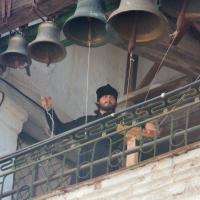for Soprano, Tenor, Bass Baritone, Chorus and Orchestra
- The Silver Sleigh Bells (Allegro ma non tanto) - Tenor and Chorus
- The Mellow Wedding Bells (Lento) - Soprano and Chorus
- The Loud Alarm Bells (Presto) - Chorus
- The Mournful Iron Bells (Lento lugubre) - Bass Baritone and Chorus
‘All my life,’ declared Rachmaninov in his reminiscences, ‘I have taken pleasure in the differing moods and music of gladly chiming and mournfully tolling bells.’ He gives two examples of their impact on the Russian soul. One is a vivid anecdote of Chekhov hearing the Vesper bells and declaring they were ‘all that religion has left me’. The other is how the ‘four silvery weeping notes’ of Novgorod’s Saint Sophia Cathedral, familiar to Rachmaninov from childhood, found their way into his First Suite for two pianos and his opera The Miserly Knight.
The bell-songs of Kolokola (to give The Bells its musical Russian title) are never far from two of Rachmaninov’s other church-related fixations – the stepwise patterns of orthodox znammeny (or ‘sign’) chant that dominate his symphonies, and the Catholic chant for the dead, the Dies irae, used to macabre effect in the orchestral predecessor to The Bells, the 1909 tone-poem inspired by Arnold Böcklin’s painting The Isle of the Dead.
The Bells is clearly the next step on that symphonic path not only because it, too, has its roots in liturgical music but also because Rachmaninov explicitly called it a Choral Symphony, not a cantata; he had already sketched a plan for a purely orchestral symphony before an anonymous correspondent sent him verses by Edgar Allan Poe in a very free translation by the Russian Symbolist poet Konstantin Balmont.
Settling in Rome for the winter of 1912–13, and occupying at first the very same rooms overlooking the Piazza di Spagna which his beloved Tchaikovsky had used as a
retreat in the late 1870s, he worked at fever pitch on The Bells from early morning to sunset every day.
He also conducted the St Petersburg premiere on 30 November 1913, and the reception was unusually perceptive, one critic noting that those familiar ‘concentrated shades of hopeless anguish and despair … pessimistic passion and sublime tragedy’ which Rachmaninov had inherited from Tchaikovsky stood revealed with ‘unusual clarity’ and ‘special force’.
Poe’s poetry, as filtered through Balmont, promises a half bright, half black ritual; but even in the first two movements pensive or sombre musical moods cloud the scene. ‘Silver Sleigh Bells’ takes up where the jubilant finale of the Second Symphony left off but with a newly refined sense of orchestral fantasy, glittering and flashing around the high tenor solo. Mysticism suspends time in a bittersweet, quasi-liturgical humming chorus as Poe writes of ‘the delight of tender sleep’ but the excitement returns to introduce a new theme at the majestic climax, descending in steps from a single, repeated high B flat. This is, in fact, the leading ‘bell song’ of the work, and as phrased by muted violas at the start of the next movement, punctuated by Mussorgskyan chimes, it comes to sound like the Dies irae.
The mood of ‘Mellow Wedding Bells’ is elusive: the soprano conveys the sensuous rapture of the bride, but that, too, is undercut by solemn choral writing and disconcerting shifts of orchestral colour. Rachmaninov’s new-found daring in harmony and subtlety of orchestration is encapsulated in the two clarinets’ last word, only reluctantly coming to rest in D major.
‘A tale of horror’ follows, with Rachmaninov unleashing all his orchestral demons to match Poe’s ‘Loud Alarm Bells’. Lurid cross-rhythms look forward to Adams and American Minimalism, but otherwise Rachmaninov is looking back to Mussorgsky and specifically to the Russian people’s plea for mercy in Boris Godunov. Rachmaninov simplified the tricky choral writing for a Sheffield Festival performance in 1936 but the original version, as performed tonight, is more overwhelming.
The slow lament of ‘Mournful Iron Bells’ emulates the finale of Tchaikovsky’s ‘Pathétique’ Symphony and at first is perhaps even more desolate in its fear of death, shared
between cor anglais and the expressive bass. At the last hour, though, redemption strikes. With a luminosity akin to Mahler in the transfigured conclusion of his 10th Symphony (which Rachmaninov would not, of course, have known), the composer glides from minor into major and movingly gives the lie to Poe: there is rest and respite beyond the quiet of the tomb.
